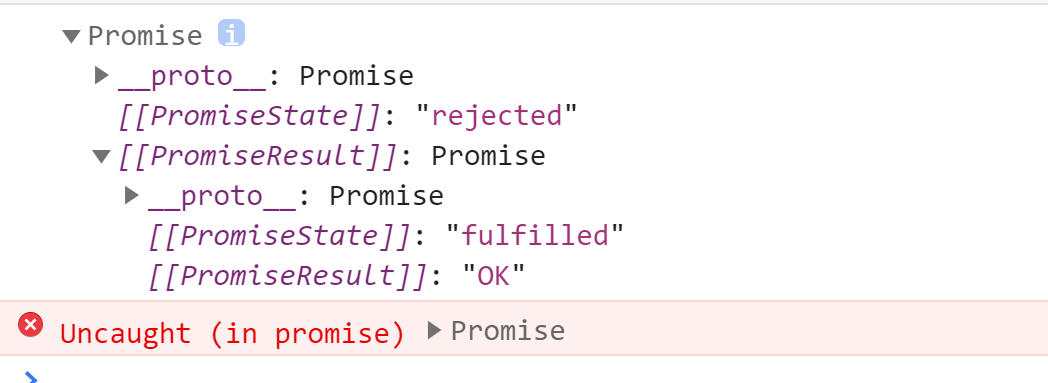引言:
感觉promise的思想非常有意思,为了代码的可读性和可维护性提供了一种新的异步编程方法,接触了一段时间的工程代码也让我体会到代码可维护,可拓展的必要性。
为什么要用Promise?
对于异步操作,例如文件读取
1
2
3
4
5
6
7
8
9
10
11
12
13
14
15
16
17
18
19
20
| var fs = require('fs')
fs.readFile('./a.txt', 'utf-8', function(err, data) {
if (err) {
throw err;
}
console.log(data);
})
fs.readFile('./b.txt', 'utf-8', function(err, data) {
if (err) {
throw err;
}
console.log(data);
})
fs.readFile('./c.txt', 'utf-8', function(err, data) {
if (err) {
throw err;
}
console.log(data);
})
|
输出结果:

由于读取文件为异步操作,输出的结果不确定。
为了a -> b -> c依次读取文件:
1
2
3
4
5
6
7
8
9
10
11
12
13
14
15
16
17
18
| fs.readFile('./src/a.txt', 'utf-8', function(err, data) {
if (err) {
throw err;
}
console.log(data);
fs.readFile('./src/b.txt', 'utf-8', function(err, data) {
if (err) {
throw err;
}
console.log(data);
fs.readFile('./src/c.txt', 'utf-8', function(err, data) {
if (err) {
throw err;
}
console.log(data);
})
})
})
|
回调函数嵌套回调函数,导致了回调地狱,带来的问题也很明显,不便于维护,阅读,异常处理。
使用promise:
1
2
3
4
5
6
7
8
9
10
11
12
13
14
15
16
17
18
19
20
21
22
23
24
25
26
| var fs = require('fs')
function myReadFile(url) {
return new Promise((resolve, reject) => {
fs.readFile(url, 'utf-8', function(err, data){
if (err) {
reject(err);
}
resolve(data);
})
})
}
myReadFile('./a.txt')
.then(value=>{
console.log(value);
return myReadFile('./b.txt');
})
.then(value=> {
console.log(value);
return myReadFile('./c.txt');
})
.then(value=>{
console.log(value);
})
.catch(reason=> {
console.log('reason', reason);
});
|
由于异常穿透,异常只需要在最后捕获,代码的可读性和维护性也更高,解决了回调地狱的问题。
Promise的工作流程

如何改变promise对象的状态?
1
2
3
4
5
6
7
8
| let p = new Promise((resolve, reject) => {
});
|



Promise Api
Promise.prototype.then
方法返回一个 ```Promise```。它最多需要有两个参数:Promise 的成功和失败情况的回调函数。1
2
3
4
5
6
7
8
9
10
11
12
13
14
15
16
17
18
19
20
21
22
23
24
25
26
|
##### Promise.prototype.then()返回的新 promise 的结果状态由什么决定?
**由 then()指定的回调函数执行的结果决定**
1. 如果抛出异常, 新 promise 变为 rejected, *[[PromiseResult]]*为抛出的异常
2. 如果返回的是非 promise 的任意值, 或者没有返回值(相当于返回undefined),新 promise 变为 resolved, *[[PromiseResult]]*为返回的值
3. ***如果返回的是另一个新 promise, 此promise的状态成为新promise的状态,此 promise 的[[PromiseResult]]就会成为新 promise 的[[PromiseResult]]***
```javascript
let result = p.then(value => {
// console.log(value);
//1. 抛出错误
// throw '出了问题';
//2. 返回结果是非 Promise 类型的对象
// return 521;
//3. 返回结果是 Promise 对象
// return new Promise((resolve, reject) => {
// // resolve('success');
// reject('error');
// });
}, reason => {
console.warn(reason);
});
|
then的链式调用
1
2
3
4
5
6
7
8
9
10
11
12
13
14
15
| let p = new Promise((resolve, reject) => {
setTimeout(() => {
resolve('OK');
}, 1000);
});
p.then(value => {
return new Promise((resolve, reject) => {
resolve("success");
});
}).then(value => {
console.log(value);
}).then(value => {
console.log(value);
})
|
Promise.resolve
- 如果传入的参数为 非Promise类型的对象, 则返回的结果为成功promise对象
- 如果传入的参数为 Promise 对象, 则参数的结果决定了 resolve 的结果
1
2
3
4
5
6
7
8
9
| let p1 = Promise.resolve(521);
let p2 = Promise.resolve(new Promise((resolve, reject) => {
reject('Error');
}));
p2.catch(reason => {
console.log(reason);
})
|
Promise.reject
Promise.reject(reason)方法返回一个失败的promise对象(无论reason是什么)
1
2
3
4
| let p3 = Promise.reject(new Promise((resolve, reject) => {
resolve('OK');
}));
console.log(p3);
|
输出:

Promise.prototype.catch
catch() 方法返回一个Promise,只处理拒绝的情况。它的行为与调用Promise.prototype.then(undefined, onRejected)相同。
Promise关键问题
Promise可以执行多个成功/失败的回调
1
2
3
4
5
6
7
8
9
10
11
12
| let p = new Promise((resolve, reject) => {
resolve('OK');
});
p.then(value => {
console.log(value);
});
p.then(value => {
alert(value);
});
|
异常穿透
当使用 promise 的 then 链式调用时, 可以在最后指定失败的回调。
前面任何操作出了异常, 都会传到最后失败的回调中处理
1
2
3
4
5
6
7
8
9
10
11
12
13
14
15
16
17
18
19
20
21
22
23
24
| let p = new Promise((resolve, reject) => {
setTimeout(() => {
reject('Err');
}, 1000);
});
p.then(value => {
throw '失败啦!';
}).then(value => {
console.log(222);
}).then(value => {
console.log(333);
}).catch(reason => {
console.warn(reason);
}).then(value => {
console.log(value)
console.log('hyz')
})
|
如何中断Promise链?
添加一个pendding状态的promise
1
2
3
4
5
6
7
8
9
10
11
| p.then(value => {
console.log(111);
return new Promise(() => {});
}).then(value => {
console.log(222);
}).then(value => {
console.log(333);
}).catch(reason => {
console.warn(reason);
});
|
Async与Await
Async/Await 是js异步编程的终极解决方案
Async函数
返回值规则与Promise.prototype.then()相同
- 函数的返回值为 promise 对象
- promise 对象的结果由 async 函数执行的返回值决定
1
2
3
4
5
6
7
8
9
10
11
| async function main(){
throw "Oh NO";
}
|
Await表达式
- await 右侧的表达式一般为 promise 对象, 但也可以是其它的值
- 如果表达式是 promise 对象, await 返回的是 promise 成功的值([[PromiseResult]])
- 如果表达式是其它值, 直接将此值作为 await 的返回值
mentoon:
- await 必须写在 async 函数中, 但 async 函数中可以没有 await
- 如果 await 的 promise 失败了, 就会抛出异常, 需要通过 try…catch 捕获处理
1
2
3
4
5
6
7
8
9
10
11
12
13
14
15
16
17
| async function main(){
let p = new Promise((resolve, reject) => {
reject('Error');
})
try{
let res3 = await p;
}catch(e){
console.log(e);
}
}
main();
|
实践:
1
2
3
4
5
6
7
8
9
10
11
12
13
14
15
16
17
18
19
20
21
22
23
| fs.readFile('./resource/1.html', (err, data1) => {
if(err) throw err;
fs.readFile('./resource/2.html', (err, data2) => {
if(err) throw err;
fs.readFile('./resource/3.html', (err, data3) => {
if(err) throw err;
console.log(data1 + data2 + data3);
});
});
});
async function main(){
try{
let data1 = await mineReadFile('./resource/1x.html');
let data2 = await mineReadFile('./resource/2.html');
let data3 = await mineReadFile('./resource/3.html');
console.log(data1 + data2 + data3);
}catch(e){
console.log(e.code);
}
}
|
async await 封装ajax
1
2
3
4
5
6
7
8
9
10
11
12
13
14
15
16
17
18
19
20
21
22
23
24
25
26
27
28
29
30
31
32
33
34
35
| <body>
<button id="btn">点击获取段子</button>
<script>
function sendAJAX(url){
return new Promise((resolve, reject) => {
const xhr = new XMLHttpRequest();
xhr.responseType = 'json';
xhr.open("GET", url);
xhr.send();
xhr.onreadystatechange = function(){
if(xhr.readyState === 4){
if(xhr.status >= 200 && xhr.status < 300){
resolve(xhr.response);
}else{
reject(xhr.status);
}
}
}
});
}
let btn = document.querySelector('#btn');
btn.addEventListener('click',async function(){
let duanzi = await sendAJAX('https://api.apiopen.top/getJoke');
console.log(duanzi);
});
</script>
</body>
|
1
2
3
4
5
6
7
8
9
10
11
12
13
14
15
16
17
18
19
20
21
22
23
24
25
26
| async function async1() {
console.log('async1 start')
await async2()
console.log('async1 end')
}
async function async2() {
console.log('async2')
}
console.log('script start')
setTimeout(function () {
console.log('setTimeout')
}, 0)
async1();
new Promise(function (resolve) {
console.log('promise1')
resolve()
}).then(function () {
console.log('promise2')
})
console.log('script end')
|





